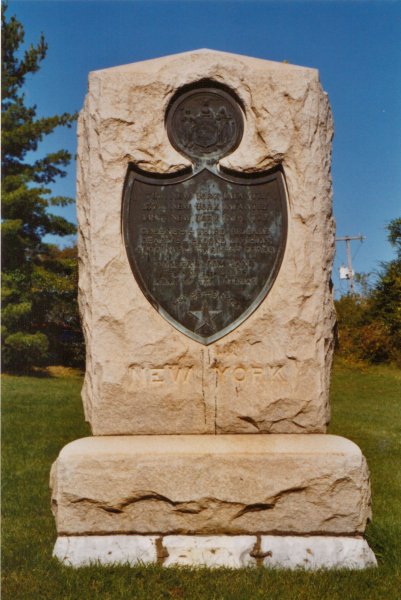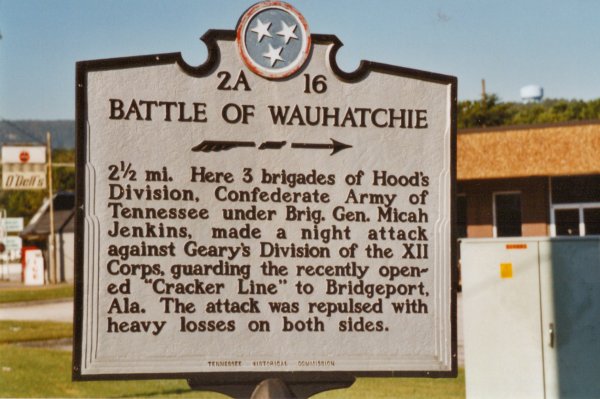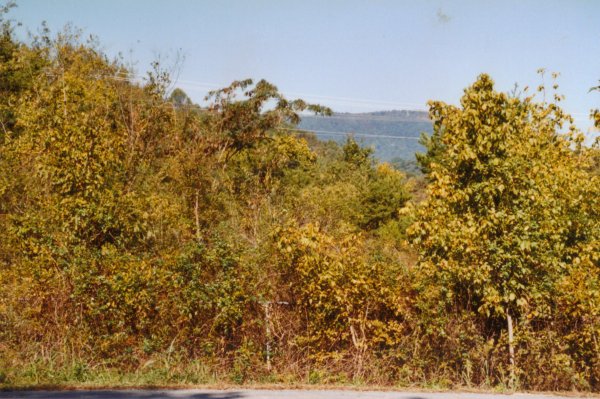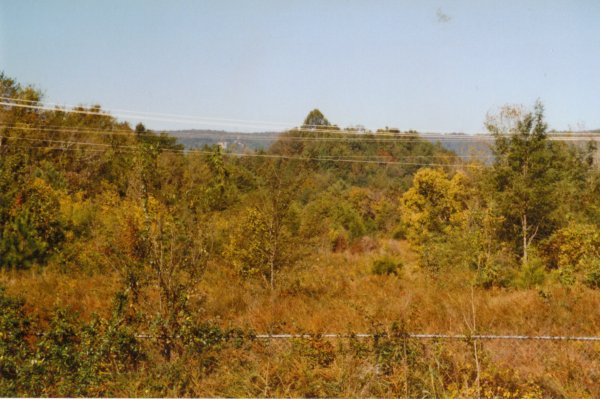
A monument to the New York Regiments
The Battle of Wauhatchie,
or The Charge Of The Mule Brigade
Wauhatchie (Lookout Valley, Brown's Ferry), 28-9 October. General James Longstreet ordered John B. Hood's Division, temporarily commanded by Micah Jenkins, to attack General John W. Geary’s 2nd Division, XII Corps, camped about three miles from Brown's Ferry in Lookout Valley.
(Wauhatchie is not among the best known battles
of the American Civil War but is one of the few rare night attacks. The ground,
as of a couple of years ago was partly built on and much of the remainder is
very overgrown.)
Just after nightfall on the 28 October three Brigades of the
Division, including Jenkins Brigade, under John C. Bratton, moved from their
positions across Lookout Mountain down a narrow path to Lookout Valley.
On arrival there a blocking force of two Brigades under
General Evander Law is put in place further up the valley. Bratton's
Brigade, the attack force, marched down the valley crossing Lookout Creek about
midnight and moved down the Wauhatchie/Brown's Ferry Road. The skirmish line is
close to the main battle line as they advance towards Wauhatchie Station with
the Palmetto's on the extreme left of the battle line and to the left of the
road.
With the skirmishers driven in the main battle lines were
in contact about 0040, with the Palmetto's engaging the 149th New York. The
Palmetto's fiercely attack 'forcing us back to a point that we were assailed
on three sides.'
The camp, wagon park and the mules were captured. At about
0200 the Brigade thought they had Geary's troops close to breaking point and
were about to launch what they believed would be the final assault when they
were informed that General Joseph Hooker leading a relieving force of XI Corps
troops were advancing to threaten their rear, due to the blocking force having
failed to stop the superior numbers sent against them.
With Federal reinforcements due to arrive on their rear Jenkins realized that the attempt to defeat Geary would fail and reluctantly called of the attack, they destroyed as many wagons as possible, drove off the mules, and made a fighting withdrawal back to their own lines arriving about 0400.
It is claimed that the mules charged through Hampton’s Legion on their rush to get away from the gunfire but I have as yet been unable to verify this. (See Grant and Howard below for alternative mule escape, which by some is claimed to be into Laws blocking force and not Bratton’s Brigade. See biblography)
Afterwards
Jenkins claimed that but 'for a few minutes (more we) would have had
the whole Yankee force and their guns captured.'
Bratton claimed the Brigade suffered 356 casualties, with 51 of
these killed, of the 1,800 engaged. Another claims Confederate losses were 34
killed, 305 wounded, and 69 missing. A source from within the 5th SC claims only
about 1,000 men in the attack and casualties of about half that number. These
figures are disputed as Geary was to claim that they found 153 killed. The
Palmetto's receive 6 killed, 35 wounded, 3 missing. Federal losses in the
battle were 78 killed, 327 wounded, and 15 missing.
The Federal quartermaster who’s
mules had supposedly made the charge supposedly forwarded this recommendation to
General Ulysses S. Grant: ‘I respectfully request that the mules, for their
gallantry in this action, may have conferred upon them the brevet rank of
horses.’ (Again not verified.)
Needless too
say the following poem is obvious a parody on Alfred Lord Tennyson's
renown ‘Charge of the Light Brigade.’
Half a mile, half a mile,
Half a mile onward,
Right through the Georgia troops
Broke the two hundred.
"Forward the Mule Brigade!
Charge for the Rebs," they neighed.
Straight for the Georgia troops
Broke the two hundred.
"Forward the Mule Brigade!"
Was there a mule dismayed?
Not when their long ears felt
All their ropes sundered.
Theirs not to make reply,
Theirs not to reason why,
Theirs but to make Rebs fly
On! to the Georgia troops
Broke the two hundred.
Mules to the right of them,
Mules to the left of them,
Mules behind them
Pawed, neighed, and thundered.
Breaking their own confines
Breaking through Longstreet's lines
Into the Georgia troops
Stormed the two hundred.
Wild all their eyes did glare,
Whisked all their tails in air
Scattering the chivalry there,
While all the world wondered.
Not a mule back bestraddled,
Yet how they all skedaddle
Fled every Georgian,
Unsabred, unsaddled,
Scattered and sundered!
How they were routed there
By the two hundred!
Mules to the right of them
Mules to the left of them,
Mules behind them
Pawed, neighed, and thundered;
Followed by hoof and head
Full many a hero fled,
Fain in the last ditch dead,
Back from an ass's jaw
All that was left of them,
Left by the two hundred.
When can their glory fade?
Oh, what a wild charge they made!
All the world wondered.
Honor the charge they made!
Honor the Mule Brigade,
Long-eared two hundred!
‘The battle lasted about one hour and a half, and was brought to a close on account of General Howard’s advance on Bratton’s rear, and not by a Confederate stampede by a ‘mule charge’ in the dark. When the order to retire was received the Brigade was withdrawn in good order.’
Major J. L. Coker, Assistant Adjutant General to Colonel Bratton, The Century, Vol. 31, Issue 4, page 623.
‘This was the place where the mules broke loose and in terror ran in squads through the enemy lines, and gave rise to the story told in verse, entitles The Charge of the Mule Brigade.’
General Oliver O. Howard, The Atlantic Monthly, Vol. 36, Issue 226, page 209.
‘The mules tied to park wagons became very restive under
the noise of the night firing. Many of them as soon as the cannon began to roar
broke away and, strangely enough, rushed straight for the enemy. Doubtless in
the dim light this was taken by the Confederates for a cavalry charge. This is
the battle in which occurred the charge of the mule brigade!’
General Oliver O. Howard, U.S.A., memoirs.
‘Geary had been engaged for about three hours against a vastly superior force. The night was so dark that the men could not distinguish one another except by the light of the flashes of their muskets. In the darkness and uproar Hooker’s teamsters became frightened, and deserted their teams. The mules also became frightened, and, breaking loose from their fastenings, stampeded directly towards the enemy. The latter no doubt took this for a charge, and stampeded in turn. By 4 o’clock in the morning the battle had entirely ceased, and our ‘cracker line’ was never afterwards disturbed.’
General Ulysses S. Grant, U.S.A., Battles and Leaders, Book 3 Page 690.

A monument to the New York Regiments

A sign near Brown's Ferry

Part of the battlefield now

Another part of the battlefield now
Newspaper, The Franklin Repository, 4 May 1864, page 2.
Colonel John C. Bratton, Official Records, Series 1, Volume 31, Part 1, pages 231-3.
General Micah Jenkins, Official Records.
General James Longstreet, From Manassas to Appomatox, chapter 32b, memoirs.
![]()